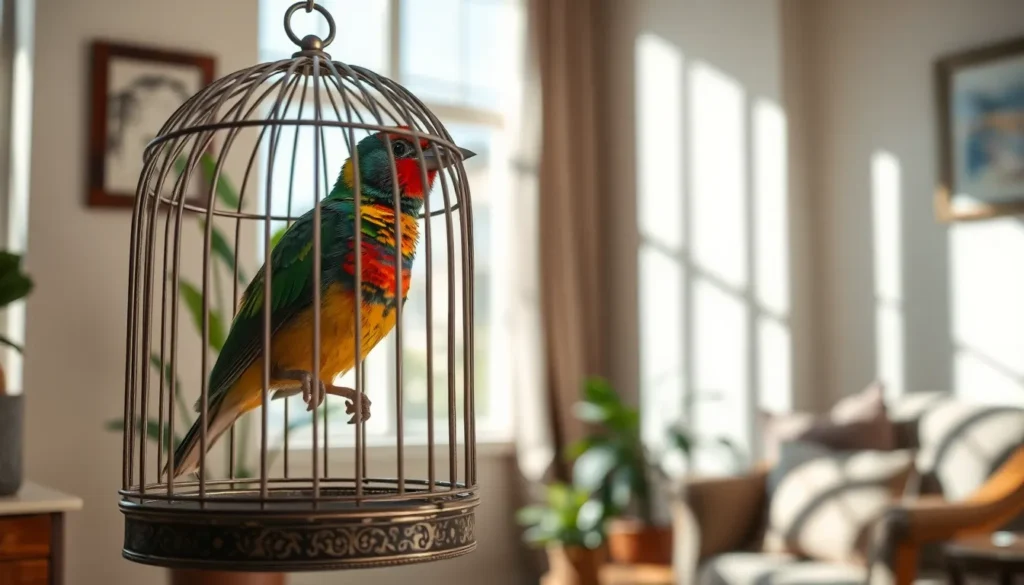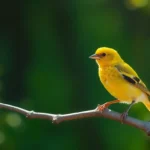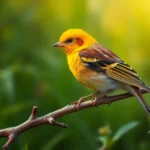We’ve all encountered that haunting image of a bird trapped behind bars while its wild counterparts soar freely through open skies. The metaphor of the caged bird resonates deeply across cultures and generations because it captures something fundamental about the human condition – our yearning for freedom and the pain of confinement.
Maya Angelou’s powerful poem “Caged Bird” transformed this simple image into one of literature’s most compelling symbols of oppression and resilience. Through her masterful contrast between the free bird and its caged counterpart she gave voice to countless individuals who’ve felt trapped by circumstances beyond their control.
Understanding the symbolism behind the caged bird opens our eyes to profound themes of liberty justice and the unbreakable human spirit. Whether we’re exploring Angelou’s literary genius or examining how this metaphor applies to our modern industry the caged bird continues to speak truths that demand our attention.
What is a Caged Bird? Understanding the Concept
A caged bird represents a powerful literary metaphor that transcends its literal meaning to embody themes of oppression, confinement, and the yearning for freedom. This symbol appears across various forms of literature, art, and cultural expression, serving as a representation of individuals or groups who face restrictions on their liberty, voice, or potential.
The concept operates on multiple levels of interpretation. Literally, we observe a bird confined within the boundaries of a cage, unable to soar freely through open skies. Metaphorically, this image transforms into a representation of human experiences marked by limitation, whether through social constraints, systemic oppression, or personal circumstances that restrict one’s ability to reach full potential.
Physical vs. Metaphorical Interpretation
| Aspect | Physical Caged Bird | Metaphorical Caged Bird |
|---|---|---|
| Confinement | Metal or wooden bars | Social, economic, or political barriers |
| Freedom | Flight and natural habitat | Self-expression and opportunity |
| Voice | Natural bird songs | Human voices speaking truth |
| Movement | Limited physical space | Restricted life choices |
Cultural contexts shape how we understand this metaphor across different societies and historical periods. The caged bird often represents marginalized communities, individuals facing discrimination, or anyone experiencing circumstances that prevent them from achieving their dreams and aspirations.
The imagery resonates particularly strongly because it captures the fundamental human desire for autonomy and self-determination. Birds naturally symbolize freedom through their ability to fly, making their captivity an especially poignant representation of lost liberty. This creates an emotional connection that helps readers understand complex themes of justice, equality, and human rights through a simple yet profound visual metaphor.
Contemporary usage of the caged bird concept extends beyond traditional literature into social movements, political discourse, and personal narratives. We see this symbol invoked when discussing issues such as systemic racism, gender inequality, economic disparity, and other forms of societal constraint that limit human potential and expression.
Maya Angelou’s “I Know Why the Caged Bird Sings”
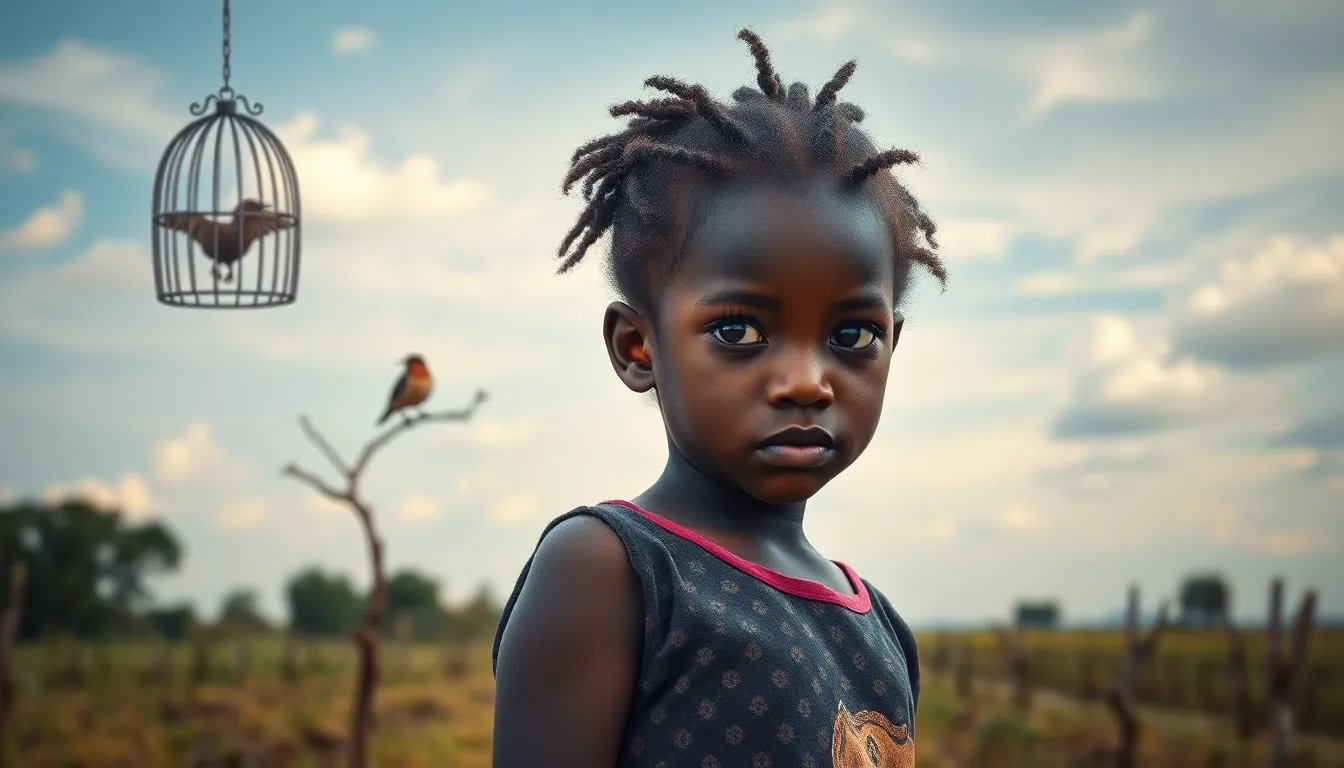
Maya Angelou’s groundbreaking autobiography “I Know Why the Caged Bird Sings” transforms the caged bird metaphor into a profound exploration of personal and collective struggle. Published in 1969, this memoir revolutionized American literature by giving voice to experiences of racism, trauma, and resilience through the lens of a young Black girl’s journey.
Literary Significance and Impact
“I Know Why the Caged Bird Sings” established Maya Angelou as a defining voice in American literature, becoming the first bestselling autobiography by an African American woman. Critics praised the work for its unflinching honesty and poetic prose, earning it recognition as one of the most important memoirs of the 20th century. Literary scholars analyze the text as a pivotal work in both the civil rights movement and feminist literature, demonstrating how personal narrative can address broader social issues.
The autobiography’s influence extends beyond literature into educational curricula nationwide, though it faces frequent challenges for its frank discussion of sexual violence and racism. Educational institutions use the text to teach students about historical injustices while examining the power of storytelling as a tool for healing and social change. Contemporary writers cite Angelou’s memoir as inspiration for their own explorations of identity and survival.
Themes of Freedom and Oppression
Angelou weaves the caged bird metaphor throughout her narrative to represent the systematic oppression faced by African Americans in the Jim Crow South. The free bird symbolizes white privilege and unlimited opportunities, while the caged bird embodies the restricted lives of Black Americans who sing even though their confinement. Economic limitations, educational barriers, and social segregation form the bars of the metaphorical cage that constrain the author’s early life.
Gender oppression intersects with racial discrimination in Angelou’s account, creating multiple layers of confinement for Black women. The memoir explores how societal expectations and limited opportunities cage women’s aspirations and voices. Physical violence and sexual trauma represent additional forms of imprisonment that silence victims and restrict their freedom to speak their truth.
Religious and cultural traditions provide both comfort and constraint within the caged bird framework. Churches offer sanctuary and community but sometimes perpetuate limiting beliefs about women’s roles and acceptable behavior. Family structures provide protection while enforcing conformity to social norms that restrict individual expression.
Autobiographical Elements
Angelou’s childhood experiences in Stamps, Arkansas form the foundation of the caged bird metaphor, with exact incidents illustrating different aspects of confinement and liberation. Her grandmother’s store serves as both a safe haven and a reminder of economic limitations within the segregated South. Educational achievements become acts of rebellion against systems designed to limit Black children’s potential and aspirations.
The author’s selective muteness following childhood trauma represents the ultimate silencing of the caged bird’s song. Professional counseling and literary mentorship help restore Angelou’s voice, demonstrating how supportive relationships can unlock the cage. Her eventual career as a performer, writer, and civil rights activist transforms personal pain into public advocacy for justice and human rights.
Personal relationships throughout the memoir illustrate various forms of caging and freedom within family dynamics and romantic partnerships. Mother figures provide both protection and pressure to conform to societal expectations of Black womanhood. Male relationships expose vulnerabilities while offering glimpses of emotional and intellectual liberation beyond traditional gender roles.
Symbolism of the Caged Bird in Literature
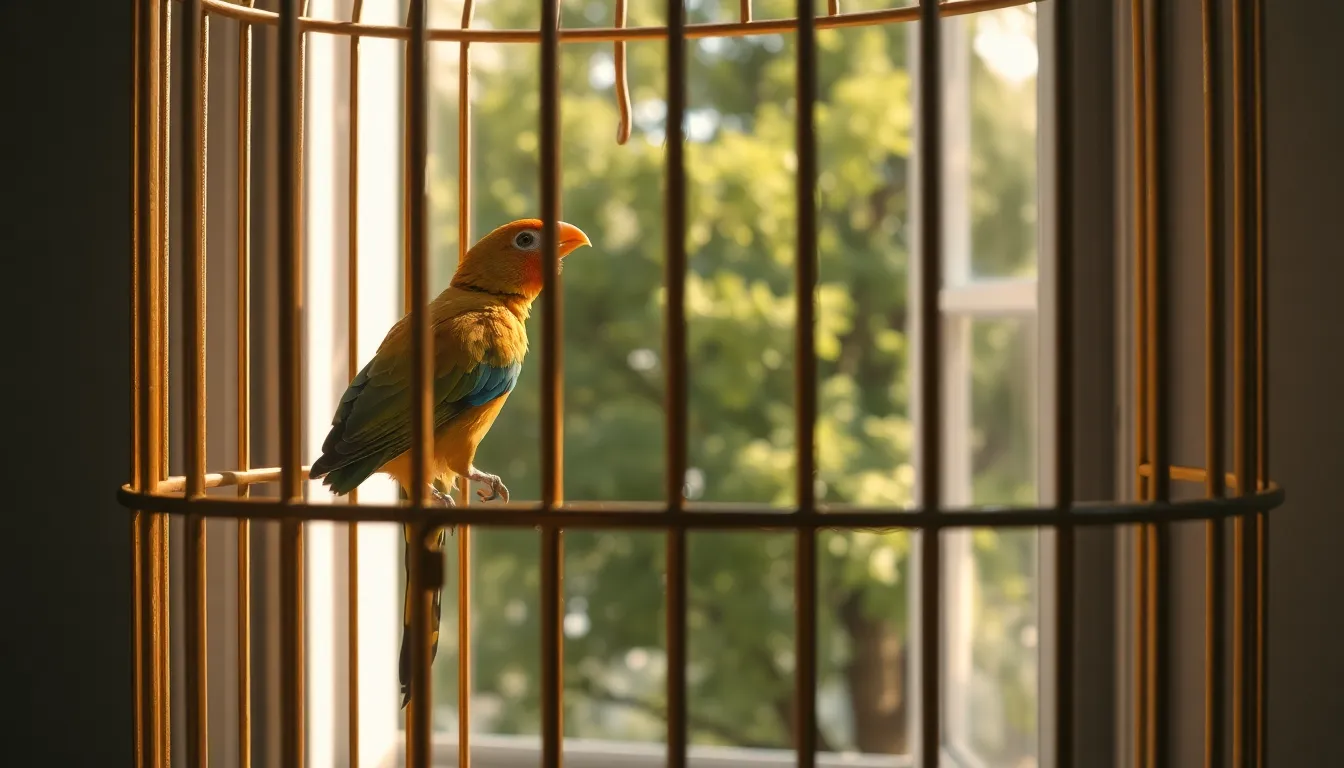
The caged bird emerges as one of literature’s most enduring symbols, representing complex themes that resonate across cultures and generations. Writers employ this powerful imagery to explore fundamental human experiences and societal structures.
Freedom vs. Confinement
Freedom represents the natural state writers associate with the caged bird’s yearning, while confinement embodies the barriers preventing liberation. Literature presents this dichotomy through vivid contrasts between soaring birds and trapped creatures behind bars. Authors like Paul Laurence Dunbar in “Sympathy” establish this framework by juxtaposing the bird’s instinctual desire to fly with physical constraints that prevent movement.
The metaphor extends beyond physical captivity to cover emotional and psychological imprisonment. Characters experiencing internal conflicts often mirror the caged bird’s struggle between desire and limitation. Writers use this symbolism to illustrate how societal expectations, personal fears, and external circumstances create invisible prisons that restrict human potential.
Contemporary literature continues this tradition by applying caged bird imagery to modern forms of confinement. Economic inequality, political oppression, and social hierarchies become the bars that trap individuals within systems they cannot escape. These literary works demonstrate how the freedom versus confinement theme adapts to address current social issues while maintaining its essential meaning.
Racial and Social Commentary
Racial oppression finds powerful expression through caged bird symbolism in African American literature. Writers employ this metaphor to articulate the experience of systematic discrimination and the longing for civil rights. The imagery captures both individual suffering and collective struggle against institutional barriers.
Social commentary emerges when authors position the caged bird as representative of marginalized communities facing systemic inequality. Literature uses this symbolism to critique power structures that limit opportunities based on race, class, or other social identifiers. The metaphor becomes a vehicle for exposing injustice while maintaining artistic subtlety.
Historical context shapes how writers carry out caged bird imagery in social commentary. During the Civil Rights era, the symbol gained particular resonance as authors connected personal narratives with broader political movements. Modern literature expands this framework to address intersectional oppression, showing how multiple forms of discrimination compound the experience of being caged.
Universal Human Experience
Human consciousness contains an inherent understanding of the desire for freedom that the caged bird represents. Literature taps into this universal experience by presenting the symbol in ways that transcend exact cultural or historical contexts. Readers across different backgrounds recognize the fundamental human need for autonomy and self-determination.
Emotional resonance occurs when writers connect the caged bird metaphor to common human experiences like unrequited love, unfulfilled dreams, or creative suppression. These themes speak to readers regardless of their exact circumstances because they address core aspects of human nature. The symbol becomes a bridge between individual experience and universal truth.
Literary traditions worldwide incorporate variations of the caged bird metaphor, demonstrating its cross-cultural relevance. Writers from different societies use similar imagery to explore themes of liberation and constraint, suggesting that the desire for freedom represents a fundamental aspect of human experience. This universality ensures the symbol’s continued relevance in contemporary literature and social discourse.
The Caged Bird as a Metaphor Across Different Works
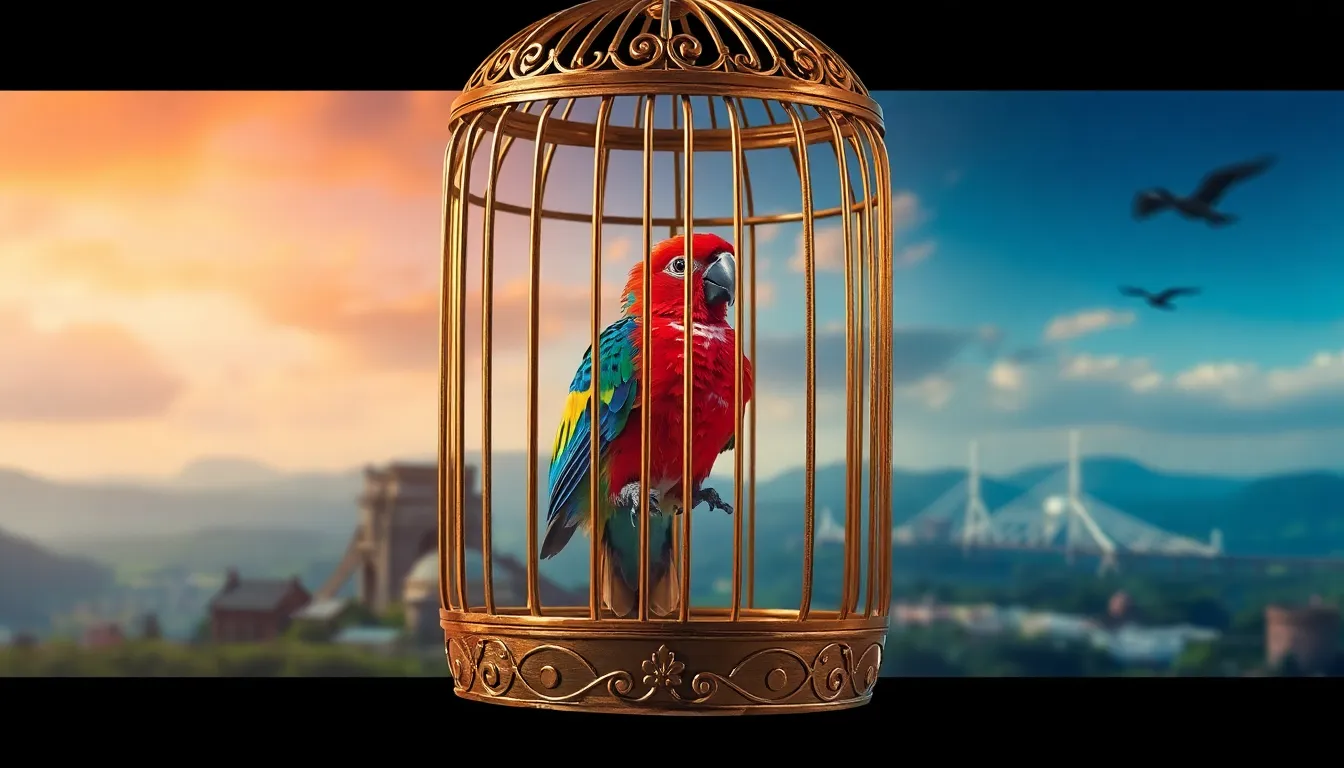
The caged bird metaphor transcends individual works to become a universal literary device that authors employ across genres and cultures. Writers consistently return to this powerful imagery to explore themes of oppression, freedom, and human resilience.
Poetry and Prose Applications
Poetry embraces the caged bird metaphor with particular intensity, allowing poets to distill complex emotions into concentrated imagery. Paul Laurence Dunbar’s “Sympathy” (1899) predates Angelou’s work by decades, establishing the foundation for this enduring symbol with lines like “I know why the caged bird sings.” Contemporary poets such as Nikki Giovanni and Langston Hughes weave similar bird imagery throughout their collections to address racial inequality and social justice.
Prose writers expand the metaphor into longer narrative forms, creating sustained explorations of confinement across entire novels. Toni Morrison’s “Beloved” incorporates bird imagery to represent the psychological aftermath of slavery, while Harper Lee’s “To Kill a Mockingbird” uses the mockingbird as a symbol of innocence destroyed by prejudice. International authors like Isabel Allende in “The House of the Spirits” employ caged bird metaphors to critique political oppression in Latin America.
Fiction writers often personify the caged bird through character development, creating protagonists whose journeys mirror the bird’s struggle for freedom. These literary works demonstrate how authors adapt the metaphor to fit exact cultural contexts while maintaining its universal appeal. Modern young adult literature frequently incorporates caged bird symbolism to address issues like bullying, family dysfunction, and identity formation.
Contemporary Usage
Social media platforms amplify the caged bird metaphor in contemporary discourse, with activists using hashtags like #CagedNoMore to mobilize support for various causes. Political movements worldwide adopt this imagery to represent systemic oppression, from Hong Kong’s democracy protests to women’s rights campaigns in Afghanistan.
Educational institutions integrate caged bird metaphors into curricula addressing topics such as immigration policy, economic inequality, and environmental justice. Mental health advocates use the metaphor to describe depression, anxiety, and other conditions that create psychological confinement. Corporate diversity initiatives reference caged bird imagery when discussing workplace barriers and glass ceiling effects.
Digital storytelling platforms showcase user generated content that reimagines the caged bird metaphor for modern audiences. Streaming services produce documentaries and series that explore how this literary device remains relevant to current social movements. Music artists across genres from hip hop to folk continue incorporating caged bird themes into their lyrics, reaching new audiences with this timeless metaphor.
Contemporary usage demonstrates the metaphor’s adaptability to address emerging forms of oppression while maintaining its core message about the universal human desire for freedom and self determination.
Cultural and Historical Context
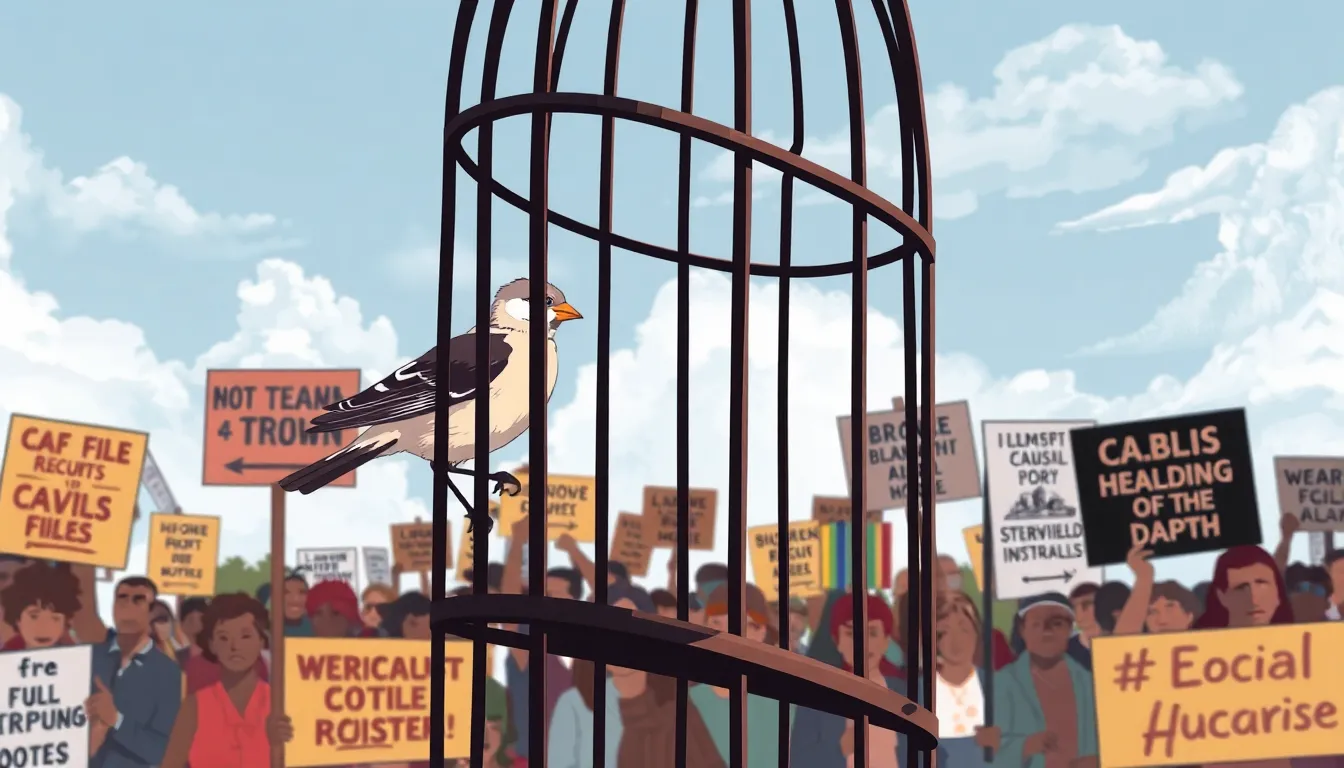
The caged bird metaphor gained profound cultural significance during pivotal moments in American history, particularly through movements advocating for social justice and equality. This powerful symbol transcended literary boundaries to become a rallying cry for oppressed communities seeking liberation from systemic constraints.
Civil Rights Movement Connections
Civil rights activists embraced the caged bird imagery as a potent symbol of racial oppression throughout the 1950s and 1960s. Leaders like Martin Luther King Jr. frequently referenced themes of confinement and liberation in speeches, drawing parallels between physical segregation and the metaphorical cages that restricted African American opportunities.
The imagery resonated deeply within Black churches, where spirituals often incorporated bird symbolism to represent the soul’s yearning for freedom from earthly bondage. Songs like “Swing Low, Sweet Chariot” and “His Eye Is on the Sparrow” established cultural foundations that made Angelou’s caged bird metaphor immediately recognizable to African American audiences.
Freedom Riders and protesters adopted the caged bird concept to articulate their experiences of living under Jim Crow laws. The metaphor provided a shared language for describing the psychological impact of segregation, where legal restrictions created invisible barriers that confined opportunities and dreams.
Educational institutions played crucial roles in disseminating this symbolism during the movement. Black colleges and universities incorporated the caged bird metaphor into literature courses, helping students understand how personal narratives could challenge systemic oppression and inspire collective action.
Feminist Literature Perspectives
Feminist writers recognized the caged bird metaphor’s power to represent women’s experiences of domestic confinement and societal limitations. Authors like Sylvia Plath and Anne Sexton employed similar imagery to explore the psychological effects of restrictive gender roles during the mid-20th century.
The concept of the “domestic cage” emerged in feminist literary criticism, examining how traditional marriage and motherhood expectations confined women’s intellectual and creative potential. Writers illustrated how societal pressures created invisible barriers that prevented women from pursuing careers, education, or personal fulfillment.
Intersectional feminism found particular value in Angelou’s work, as it demonstrated how race and gender oppression compounded to create multiple layers of confinement. This perspective highlighted how women of color faced unique challenges that couldn’t be addressed through single-issue approaches to liberation.
Contemporary feminist scholars continue analyzing the caged bird metaphor’s relevance to modern women’s experiences. Issues like workplace discrimination, reproductive rights restrictions, and caregiving expectations create new forms of metaphorical cages that limit women’s autonomy and self-determination across different cultural contexts.
Critical Reception and Analysis
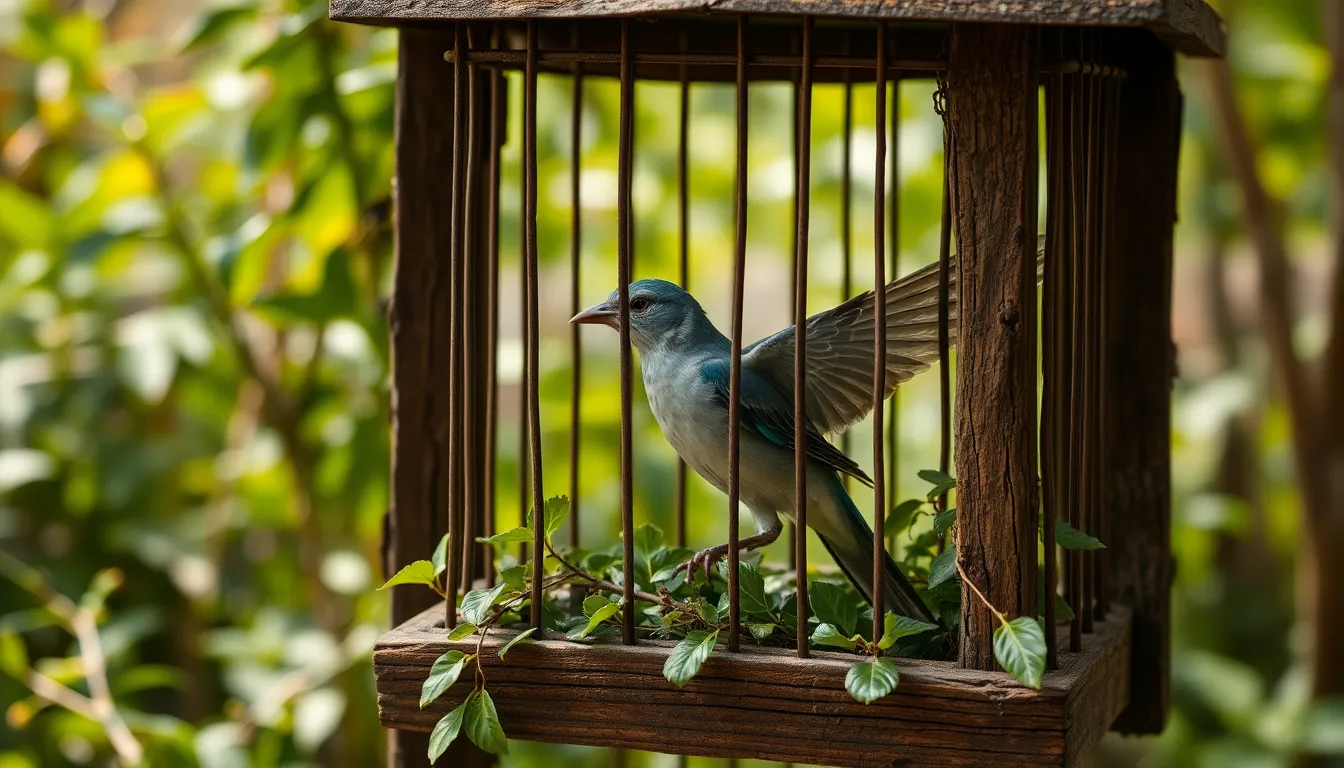
The caged bird metaphor has garnered extensive scholarly attention and widespread reader acclaim since Maya Angelou’s groundbreaking work transformed literary discourse. Critics and readers alike recognize the profound impact of this symbolic framework on American literature and social consciousness.
Academic Interpretations
Literary scholars examine the caged bird metaphor through multiple theoretical frameworks that illuminate its complex meanings. Postcolonial critics analyze how the metaphor exposes the psychological violence of systemic oppression, with Dr. Dolly McPherson noting that Angelou’s work “transforms personal trauma into collective resistance narrative.” Feminist scholars interpret the imagery as a critique of patriarchal structures that limit women’s agency and voice, particularly emphasizing the intersectional experiences of Black women.
Psychological readings focus on the metaphor’s representation of trauma recovery and resilience. Academic journals consistently highlight how the caged bird represents what Dr. Susan Gilbert calls “the journey from victimization to empowerment through narrative reclamation.” Marxist interpretations examine the economic dimensions of the metaphor, analyzing how class structures create invisible cages that limit social mobility.
Contemporary scholars connect the caged bird imagery to modern theoretical frameworks including critical race theory and intersectionality studies. Universities across the United States incorporate these interpretations into curricula spanning literature, sociology, psychology, and African American studies programs.
Reader Response and Reviews
Readers consistently describe the caged bird metaphor as groundbreaking and emotionally resonant across demographic boundaries. Book reviews from major publications including The New York Times and The Washington Post emphasize the metaphor’s ability to make abstract concepts of oppression tangible and relatable.
Online platforms demonstrate the metaphor’s continued relevance through thousands of reader discussions on Goodreads, Reddit, and literary forums. Readers frequently describe personal connections to the imagery, with many stating the metaphor helped them articulate their own experiences of limitation and confinement.
Educational reviews from teachers and professors highlight the metaphor’s effectiveness as a pedagogical tool for discussing complex social issues. Student responses consistently indicate that the caged bird imagery facilitates deeper understanding of historical and contemporary justice movements.
International readers translate the metaphor’s significance across cultural contexts, with reviews from readers in Asia, Europe, and Africa noting universal themes of human dignity and freedom. Literary magazines report that the caged bird metaphor ranks among the most frequently quoted and referenced symbols in contemporary American literature discussions.
The Lasting Legacy of Caged Bird Imagery
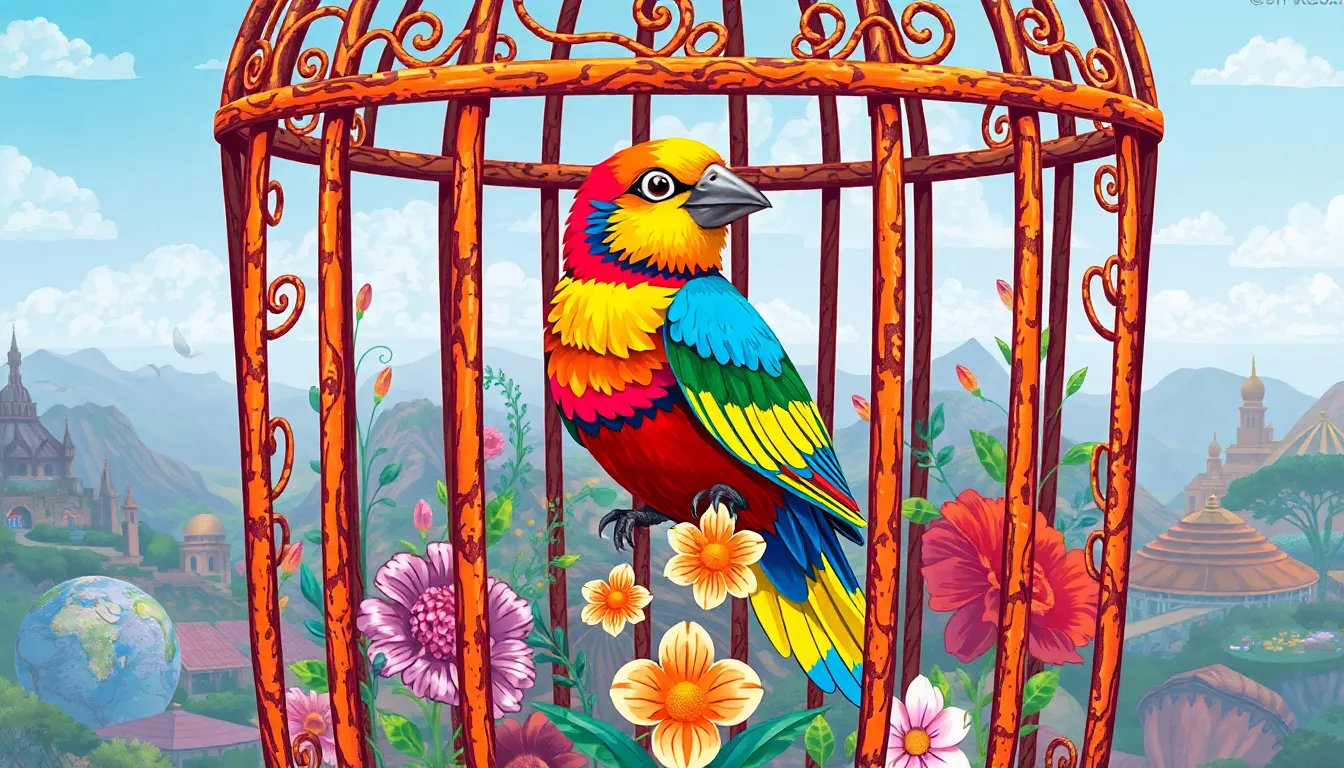
Caged bird imagery continues to shape contemporary literature and social discourse decades after Angelou’s groundbreaking work established its cultural significance. Modern writers across genres incorporate this metaphor to address emerging forms of oppression, from digital surveillance to economic inequality. The symbolism transcends its original context, adapting to reflect new challenges while maintaining its core message of resilience and the pursuit of freedom.
Educational institutions worldwide have integrated caged bird themes into curricula spanning literature, history, and social justice studies. Students from diverse backgrounds connect with the metaphor’s universal appeal, using it to examine their own experiences of limitation and aspiration. Teachers report that this imagery facilitates meaningful discussions about systemic barriers and personal agency across different cultural contexts.
Cultural Impact Across Generations
Literary scholars document the metaphor’s influence on emerging authors who reference Angelou’s work while developing their own narratives of confinement and liberation. Contemporary poets like Amanda Gorman and Warsan Shire employ similar avian imagery to address modern issues affecting marginalized communities. Their works demonstrate how the caged bird metaphor evolved to cover new forms of restriction while preserving its emotional resonance.
Social media platforms amplify the metaphor’s reach as activists and content creators use #CagedBird hashtags to highlight contemporary injustices. Digital storytelling initiatives incorporate bird imagery to document personal testimonies of overcoming adversity. These platforms transform individual experiences into collective movements, extending the metaphor’s influence beyond traditional literary boundaries.
Therapeutic and Psychological Applications
Mental health professionals use caged bird symbolism in therapeutic settings to help clients articulate feelings of entrapment and envision pathways to healing. Art therapy programs frequently incorporate bird imagery as patients explore their own experiences of confinement and recovery. Research indicates that metaphorical expression through familiar symbols like the caged bird enhances therapeutic outcomes for trauma survivors.
Recovery communities have adopted the metaphor to describe addiction’s constraints and the journey toward sobriety. Support groups reference the caged bird’s song as representing hope maintained even though difficult circumstances. These applications demonstrate the metaphor’s adaptability to address contemporary mental health challenges while honoring its literary origins.
Global Recognition and Translation
International translations of Angelou’s work have introduced the caged bird metaphor to global audiences, where local writers adapt its themes to reflect region-exact struggles for freedom. African writers employ similar imagery to address post-colonial challenges, while Asian authors use bird symbolism to explore cultural expectations and individual expression. These adaptations prove the metaphor’s cross-cultural relevance and enduring power.
Academic conferences dedicated to Angelou’s legacy regularly feature panels examining the caged bird metaphor’s influence on industry literature. Comparative literature studies analyze how different cultures interpret and modify the symbolism while preserving its essential meaning. This scholarly attention ensures the metaphor’s continued evolution and relevance across diverse cultural contexts.
Conclusion
The caged bird metaphor continues to soar beyond its literary origins proving that powerful symbols transcend time and cultural boundaries. We’ve seen how this imagery transforms personal struggles into universal statements about human dignity and the relentless pursuit of freedom.
What makes this metaphor particularly compelling is its ability to adapt and remain relevant across generations. Whether we’re discussing historical civil rights struggles or contemporary social justice movements the caged bird speaks to anyone who’s felt the weight of limitation or dreamed of breaking free.
As we move forward the caged bird reminds us that literature’s greatest gift isn’t just entertainment—it’s the power to give voice to the voiceless and hope to those who need it most.
Frequently Asked Questions
What does the caged bird symbolize in literature?
The caged bird symbolizes human longing for freedom and the pain of confinement. It represents individuals or groups facing restrictions on their liberty, voice, or potential, often embodying themes of oppression and the fundamental human desire for autonomy and self-determination.
Who wrote the famous poem “Caged Bird”?
Maya Angelou wrote the famous poem “Caged Bird,” which contrasts the lives of a free bird and a caged bird. The poem gives voice to those who feel trapped by their circumstances and has become an iconic piece of American literature.
What is “I Know Why the Caged Bird Sings” about?
“I Know Why the Caged Bird Sings” is Maya Angelou’s groundbreaking 1969 autobiography that explores her childhood experiences with racism, trauma, and resilience. The memoir uses the caged bird metaphor to represent systematic oppression faced by African Americans in the Jim Crow South.
How is the caged bird metaphor used in contemporary social movements?
The caged bird metaphor is used in modern social movements to address issues like systemic racism, gender inequality, and economic disparity. It appears in social media activism, political discourse, and digital storytelling platforms, highlighting ongoing struggles for freedom and justice.
Why is the caged bird metaphor significant in African American literature?
The caged bird metaphor is significant in African American literature because it powerfully expresses racial oppression and serves as social commentary. It critiques power structures that limit opportunities based on race and became particularly prominent during the Civil Rights era as a rallying cry for equality.
How does the caged bird represent feminist themes?
From a feminist perspective, the caged bird represents women’s experiences of confinement and societal limitations. It explores the psychological effects of restrictive gender roles and addresses modern issues like workplace discrimination and reproductive rights, particularly highlighting challenges faced by women of color.
What makes the caged bird a universal literary symbol?
The caged bird is a universal literary symbol because it connects readers across different backgrounds to the fundamental human desire for autonomy. Its themes of freedom versus confinement resonate across cultures and generations, making it relevant in various contexts and contemporary discussions about human rights.

